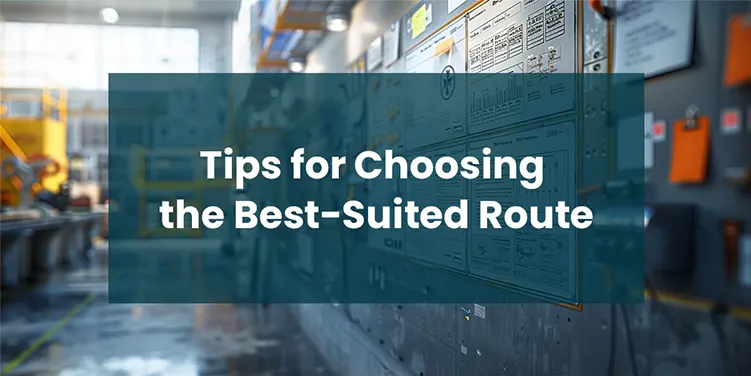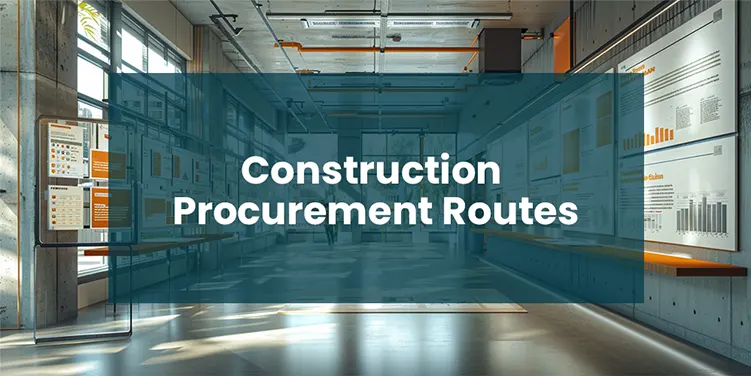Procurement, the backbone of the construction industry, is the strategic process of sourcing goods, and services necessary for the completion of the success. It is not only about buying the materials; but also about aligning the resources, ensuring the quality, and managing the risks.
According to the McKinsey Report, procurement accounts for 40 to 70% of a company’s total spending, ensuring the successful completion of a project.
Simply put, procurement in construction is akin to navigating a ship through treacherous waters. Just like a ship captain who must anticipate the potential hazards & chart a successful course, a professional should also plan carefully, identify the bottlenecks, and select a suitable procurement route. The success of a project depends on choosing the right procurement route. The Construction Procurement Routes determine how the resources & designs are aligned with project goals and the responsibilities are distributed among the different stakeholders. An optimized procurement route ensures risk management, cost control, quality assurance, and time efficiency. Choosing the accurate route also helps in debunking legal & contractual complications, bringing sustainability & innovation to projects, and shaping stakeholder relationships.
Impacts of Inefficient Procurement Routes
One cannot deny the effects of inefficient procurement routes on project completion. Poor understanding of the Procurement Routes For Construction not only cast a shadow on the project timeline. To make matters worse, inefficiency creates a domino effect, leading to a topsy-turvy situation. Shoddy procurement practices lead to cost overruns due to additional expenses and skyrocketing prices of the materials. Regarding the project timeline, the picture is not very rosy. Poorly managed routes can cause unnecessary delays & reputational losses, disrupting the coordination with already-planned project schedules. The same is the case with the quality of the procured materials. The incompatibility of the route with project objectives sacrifices the quality of the assigned resources.
If you don’t want to sacrifice your project cost & time efficiency and timeline, you must look for the precise route.
This blog will delve into the 6 Key Procurement Routes that are used to enhance the productivity & efficacy of your Procurement Construction project. Let’s explore all the procurement options!
Salient Procurement Routes in Construction
Procurement Routes in Construction are the strategies for analyzing & selecting a way the project is delivered. These well-organized routes handle the quality & cost of the project and define relationships & responsibilities among clients, contractors, and other stakeholders.
Whatever the nature of your project, these routes always come in handy. Let’s look at these routes one by one to understand the main differences. So you can decide later on which route would be the most beneficial and tailored to your project’s needs.
- Traditional Procurement (Design-Bid-Build)
- Design and Build
- Management Contracting
- Construction Management
- Integrated Project Delivery (IPD)
- Public-Private Partnership (PPP)
1. Traditional Procurement (Design-Bid-Build)

When you first read the name, you must think of it as a weary and conventional route. To your surprise, this is not true! If you are looking for a classic procurement approach with clear roles, cost certainty, and well-defined work scope for your construction project, this is the best-suited route. In this route, the client appoints an architect or designer to build a design for the project. The completion of the design is followed by a competitive tendering process. The contractors bid on the fully designed project. After winning the bid, contractors start the construction of the project as per design.
Advantages
- The primary advantage of traditional procurement lies in the clear separation of the responsibilities between designers & contractors.
- The well-defined division of responsibilities facilitates transparency.
- In this route, the clients experience great control over design development, ensuring the quality & personalization of the project.
- A competitive bidding process may result in cost savings.
Disadvantages
- In the traditional route, the risk of arising disputes between contractor & designer multiplies due to split responsibility and accountability.
- The owner faces potential delays due to lengthy and cumbersome sequential processes.
The design of the project can be inflexible. In the case of change, the client can incur a heavy cost.
2. Design and Build

Unlike the traditional route, the Design and Build approach aims to streamline the contractual responsibility in the hands of one entity. In this route, the contractor holds a prominent position. The project owner appoints a contractor and entrusts the responsibility of designing & construction to him, obliterating any chance of conflict. The client prepares the project specification and hands it over to the contractor for design and build. At this stage, the contractor has also the choice to relegate his architectural responsibility to the sub-contractor. Among Procurement Routes For Construction, this collaborative route unlocks a plethora of dividends. According to the Procurement Trends Survey 2024, around 67% of the projects use design and build procurement routes for high efficacy.
Benefits
- Single point of responsibility is the main benefit as the contractor is fully responsible for design and build, minimizing the chances of discrepancies.
- Fast delivery of the project timeline due to overlapping of design and construction phases.
- Due to minimum chances of irregularities, the clients enjoy cost certainty & savings.
- Simplified payment as the owner has to pay only a single party.
- Uninterrupted communication between contractual parties.
Drawbacks
- The clients start losing authority over the design, thereby jeopardizing their personalized requirements.
- The quality of the project may be compromised if the contractor prioritizes cost-savings over quality of resources.
- Limited creativity & input in design selection.
3. Management Contracting

If your project is medium to large demanding complex designs, what could be the other option than adopting Management Contracting among different Construction Procurement Routes?
In this route, the project owner hires a contractor to manage and oversee the design and construction phase. The actual work is performed by trade contractors who design & build your construction project. It involves individual trade packages and tenders them out to separate contractors. Each contract is individually awarded by the client and supervised by the management contractor. This route also comes with pros and cons.
Pros
- The involvement of the management contractor offers constructability expertise and value engineering suggestions.
- High efficiency of the project due to the role of the management contractor in minimizing risks, optimizing trade contractors, and improving coordination.
- Flexibility to start the construction phase before the completion of design.
- Single point of contact for the owner.
- High potential for cost savings by eliminating the role of contractors.
Cons
- High coordination cost due to multiple contracts & complexity.
- More risk for cost overruns faced by clients due to management fees.
- The exact completion date of the project is uncertain as compared to the traditional route.
4. Construction Management

In Construction Management, the project owner hires a construction manager to act as an agent to manage the construction process. He also assigns a series of construction roles to the contractors to carry out the work. This kind of procurement route is best suited for larger & complex projects, having internal management resources. If you are looking for the optimized route for FF&E and OS&E Procurement, Construction Management will magnify the chances of success. Let’s explore its pros and cons for better understanding!
Pros
- High level of client control over the different aspects of the project.
- Flexibility in choosing the design and construction sequencing.
- Maximum potential for cost savings due to the supervision of the construction manager.
- Effective coordination is ensured by the manager between the client & sub-contractors.
Cons
- The route requires a detailed scope given the complexity of the project.
- The project cost is not fixed and can be derailed easily due to cost uncertainty.
- The client assumes more risks and responsibilities.
5. Integrated Project Delivery (IPD)

Integration will take your mind towards high collaboration. This is precisely true! Integrated Project Delivery is an effective approach that integrates all the members involved in the project to harness the insights and talents of all the participants. The client hires key participants such as architects, contractors & subcontractors. This route is marked by collaborative decision-making and shared risks & benefits. Consequently, optimal results can be expected from the IPD procurement route.
Benefits
- This route presents a high ratio of success due to a collaborative framework in every decision.
- Potential for significant cost savings and improved project outcomes.
- High chances of innovations due to shared ideas.
- Risk sharing among the different stakeholders.
- Reduced chances of conflict.
Drawbacks
- The participants can experience legal and contractual complexities.
- If a single partner fails to honor his commitment, the chances of successful project completion can be dimmed.
- An integrated approach demands a high level of trust, cooperation, and teamwork.
6. Public-Private Partnership (PPP)

If you are the owner of large & complex infrastructural projects like Energy Sector Procurement, Public-Private Partnership is the best possible route to gain maximum efficiency. A PPP involves a partnership between a public-sector client and a private-sector provider. In these projects, the public sector puts forth the requirements of the project. The private sector is responsible for the design, construction, financial & cost management, and operational management for a long period. The clients can easily capitalize on the expertise and in-depth knowledge of private sector professionals, uplifting the chances of success in complex infrastructure projects.
Benefits
- Leverage the expertise and acumen of the private sector in infrastructure projects.
- Easy access to private-sector funding for a long-term.
- In this route, financial shifts can easily be shared with private partners.
Drawbacks
- Potentially high costs for the public sector.
- Complex contractual arrangements among the different stakeholders.
- Less flexibility in making the changes once the contract is signed.
Balancing the private & public sector interests could be difficult.

Tips for Choosing the Best-suited Route Among Construction Procurement Routes
Among the aforementioned Procurement Routes in Construction, the client has to choose the best one, ensuring the success of the infrastructural project. Here are some specific guidelines the clients must read to opt out of the suitable procurement route. Choosing the right route for your project depends on certain factors.
- Before choosing the right route, you must understand your project requirements including its scope & complexity, budget & cost controls, and time constraints associated with your project timeline.
- Considering the client’s expertise and experience will also help to opt out of the preferred route. If the client has limited experience in the management of construction projects, opting out of the route with a strong management component will pay dividends.
- Market conditions should be carefully analyzed. You should also analyze the availability of contractors. In a highly competitive market, a procurement route that attracts competitive bids might be preferable.
- Quality requirements should not be neglected. If design quality & flexibility are a priority for you, what could be better than choosing a traditional procurement route where you have complete control over design?
- For large and complicated projects, all-out collaboration and coordination become the need of the hour. You must choose a route where you can engage with all key stakeholders without any reservations.
- Analyzing the procurement options is also indispensable. For instance, if you want cost certainty and well-defined scopes, the traditional route is the best one. In projects where cost efficiency & timeline are prioritized, Design & Build could be the preferable choice. Construction management is ideal with robust management ingredients and Management Contracting is useful for multi-package projects with a high level of coordination.
- Adaptability to future needs is another you should also consider when choosing the route that aligns with your project goals.
By considering these specific requirements, you can easily decide on a good & efficient Procurement Routes Construction for your projects.
Are You Looking For Expert Guidance for Informed Procurement Decisions?
If you have undertaken a project & clueless about choosing the right procurement route, you must look for expert guidance. Subpar procurement services can also weigh heavily on your budget. Above all, choosing an incompatible procurement route can further worsen the situation. This is why Delta Gulf Overseas is here at your service to guide you throughout the procurement journey. Our experts schedule meetings with the clients and help them assess the requirements of projects involving complexity, cost certainty, design flexibility, and financial requirements. After analyzing the requirements of the projects, our experts offer the best possible procurement routes tailored to your project needs. With our deep industry knowledge and proven strategies, we will ensure that you get the best value for your investment. Whether you want to choose the route for FF&E and OS&E, and Energy Procurement, avail of our services for navigating Procurement Routes Construction. Contact us now!
Final Thoughts
To sum up the procurement routes, one cannot deny the importance of choosing the right procurement route for the construction project. Unnecessary project suspension, cost overruns, poor quality, and disputes can affect the successful completion of the project. Only well-optimized and executed Procurement Routes Construction can be the game-changer for your project. If you want to experience a successful project, let us help you choose the route according to your project. Hire the procurement experts of Delta Gulf Overseas. To further explore the procurement services that we offer, visit our website.





